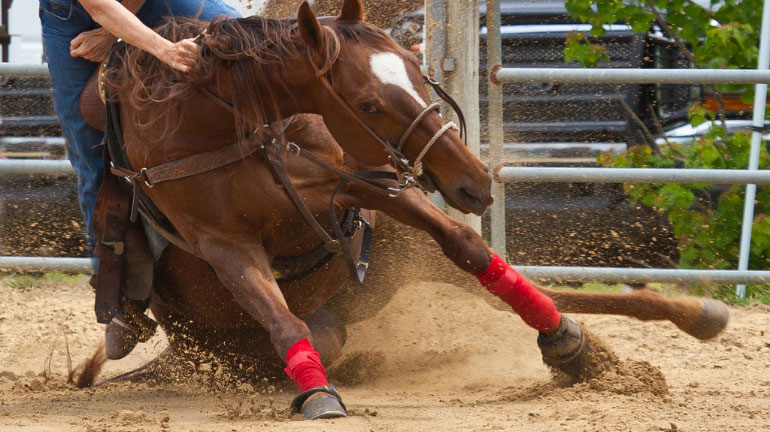There's a lot of confusion about gait normalities and shoeing horses. Back in the heyday of horses in the 1800s and early 1900s, people shod their horses every 28 days. Those horses' work-life was only four to five years.
The shoes they used to correct overreaching and other gait issues were highly aggressive. However, since the horse would only last a maximum of five years, they were acceptable. This is not the case today.
We've recently gotten some questions from the public that we want to address on this issue. Here is one:
"My horse stumbles in lessons. My trainer told me to tell my farrier to roll the toes on my horse's shoes. So he did, but my horse still stumbles. Is there a special way to roll the toes of the horseshoes to stop stumbling? Or do I need a better farrier that knows what he's doing?"
This farrier did his job well, and since the horse is still stumbling, he lost a client and damaged his reputation. However, the reality of this situation is that it's not the farrier's fault.
Conformational Issues Cause Stumbling
Many factors can make a horse stumble that have nothing to do with their shoes.
The biggest problem is conformation, the horse's body in its natural state. Any confirmation that makes a horse heavy on his front end will cause a delay in the break-over. His weight passes over his front limb, causing him to keep his feet close to the ground to keep his nose out of the dirt. This makes that horse predisposed to stumbling.
We can also have horses that stand under in the front, like a downhill skier making them heavy on the front end. Some horses are higher in the rear than the front. Those guys are going to be heavy on the front end. Horses with very long backs are prone to lumbar-sacral problems that cause them to load the front end to relieve discomfort.
A post-legged horse often doesn't want to work off his back end because mechanically, he can't. His legs are too straight. Horses with long necks disproportionate to their bodies are heavy on the front end. All of these horses stumble, and the reasons for the stumbling have nothing to do with their shoes.
Any conformational problems can be made worse with improper riding. For example, if a rider does not correctly engage their horse's back end, the situation will only worsen with time, and no shoer can fix it for them.
Even if the toes are backed up like they're supposed to be, the break-over is where it's supposed to be, and lateral and medial balance is good; conformation defects can create a significant stumbling problem for horses.
Reasons Horses Stumble That Can be Fixed Without a Farrier
Young horses often stumble as they get used to carrying a rider even if there is nothing wrong with them. Every time the rider shifts their weight in the saddle, the horse must learn to compensate and respond. It simply takes time for young horses to learn where their feet are.
Out-of-shape horses are also very prone to stumbling. When you ride an out-of-shape horse aggressively on occasion but never give them the consistency they need to get fit, they'll have gait problems. The coordination of their muscles is not there - fatigue causes horses to stumble.
Movement is just a matter of timing between muscles. When that timing gets off, you're going to have some stumbling. The worst thing you can do is ride your horse heavy, let him sit, ride him heavy and let him sit on repeat. The gait problems he will experience from this are not because of his shoes.
As horses age or get used more, they can develop arthritic changes in their joints. They won't be able to flex their knees and fetlocks as well as they once could. They keep them low to the ground, increasing their chances of stumbling. A rocker toe shoe will not resolve in a therapeutic condition like a horse with bone changes in the knee.
An odd one that we see every once is an upper fixation of the patella. That's in the stifle joint. The medial patella ligament catches on the end of the femur, and that horse's leg locks in rigid extension. The front end is not prepared to pick up his feet, so he stumbles.
How to Watch Your Horse's Gait
Take a look at the horse. Is he traveling well, or is he developing a lameness issue that makes him stumble that has nothing to do with his feet?
When you watch a horse walk toward you, the first thing you want to see is that there's a little bit of daylight between his foot and the ground as he comes in. Then, you want to see them hit on their heel and then land. Some horses can land flat and not have any problems. But, a horse that lands toe first has a problem. Something's going on inside that foot, causing him to keep his weight off his heels.
As we mentioned above, another reason for stumbling is rider error. How do we tell someone that the problem with their horse is horrible confirmation and lousy riding?
Take a look and try to determine why this horse is stumbling. What things are causing this horse to stumble that may have nothing to do with the horseshoe? Have a pleasant conversation with the client if you can pull it off without insulting them. We wish you luck!
Ready to start your career as a farrier? Apply Now
